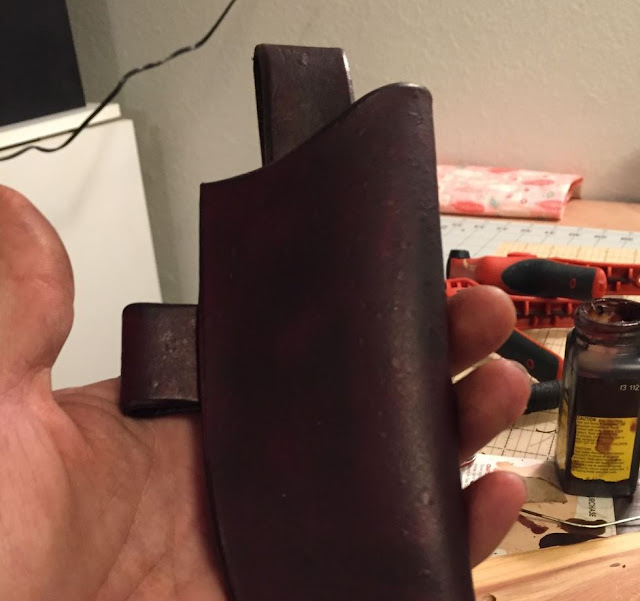I broke this build into two parts because is was so picture laden.
If you missed part one, you can see it here.
Next step is to make and install the handle. I have selected to use a piece of walnut.
After choosing your material, trace out the handle on the material and rough cut.
After I do the rough cut I drill the holes for the pins. first drill one
half of the handle through the blade, then flip over and drill through
the blade and the first scale into the second scale.
As you can see in the previous photo I have taped up the finished blade
to prevent scratching or getting epoxy on it. The next step is of course
applying the handle. The steel should be clean and free of loose
materials or oils. I use lacquer thinner to do this. Some woods are very
oily and need to also be wiped clean of oil with the thinner.
The handle should then have the shit clamped out of it. Go ahead and fit all the clamps you can find.
The squeeze out should be cleaned off the blade area at this time.
The next step after waiting for the glue to dry is to sand the handle
down to meet your design criteria. I will be making a very rounded and
smooth handle.
All sanding is done by hand while rounding the handle. Starting with 80 grit and working up to 400.
Once sanded I have applied a healthy coat of linseed oil. The oil will
swell the fibers in the wood. I will then sand one final time with 400
grit paper and reapply some linseed oil.
The next step is to sharpen. There are a million ways to get this done. I
have been having good results using a lansky system. When making a edge
on a new knife it is necessary to start from the lowest grit stone and
work up to the finest. Unfortunately the finest one that I have in this
kit is the 1000 grit. For stainless knives I find it acceptable, carbon
steel seems to be able to take a finer edge. So what I have done is to
tape a piece of paper onto the 1000 grit stone and coat it with some
polishing compound. I used that until I had a nice mirror polish on the
edge and it would easily shave hair.
I debated if I would include the sheath build. I will, but please bear
in mind that this is my fourth sheath build and I am sure there are
better ways to do this work. I have learned a lot of what I do know by
watching some youtube videos. There is a knife builder in the UK who
goes by Jacklore knives, his work is exceptional and he has a video
available on sheath making. I recommend it.
You will need some
tools. Here I have an edger, a groover, a stitch layout tool, a scribe
that I will be using as a punch and a freshly sharpened knife. I also
used a few consumables die, waxed nylon thread, contact cement and of
course leather.
First step is to make a template. Then of course transfer to leather and
cut out. Here I have wet the leather where the bend will be, this helps
to prevent cracking.
Here I have prepared the welt and glued it in. You can see on the upper
piece that I have used the contact cement for this. I left a space in
the welt to install the ferro rod loop
Here you can see I have prepared the ferro rod loop and the belt loop.
Both pieces have been dyed and had the edges burnished to smooth them
out. To do this you profile the leather on the edges and then apply some
bar soap, you can then rub the edges with a smooth roundish object to
get a nice smooth appearance on the edge. They make a tool for this
called a slicker, I did not have one at the time. I did receive one for
Christmas this year though. Also you can see that I have done the
layout, grooving and punched holes for stitching the belt loop on.
The next step is to dye the sheath. I prefer to do the inside also.
After that the belt loop is glued into place.
The belt loop is then stitched into place. As seen in the previous photo
I prefer to groove the inside of the sheath so that the threads are
protected slightly from being cut by the knife sliding in and out of the
sheath.
The next step is to glue the sheath shut. Here you can see the sheath
has been glued, the edges sanded smooth, dyed, edges profiled, rubbed
with soap, and burnished. I have done this prior to installation of the
ferro rod loop as it would make these tasks more difficult.
Here you can see the addition of the ferro rod loop.
Here you can see I have grooved for stitching and done the stitching layout.
Here you can see that the sheath has been stitched and aside from some
boot grease to soften and seal the leather it is complete.
And now for the completed knife porn. This has been the most difficult
of the five knives I have made and also has turned out the best. Also I
have the most hours into this one. I estimate 20 hours of work went into
this. Thanks for looking. I appreciate any questions or comments. I
will follow up at some point with a link to the many videos that I have
used as reference for this work.
























